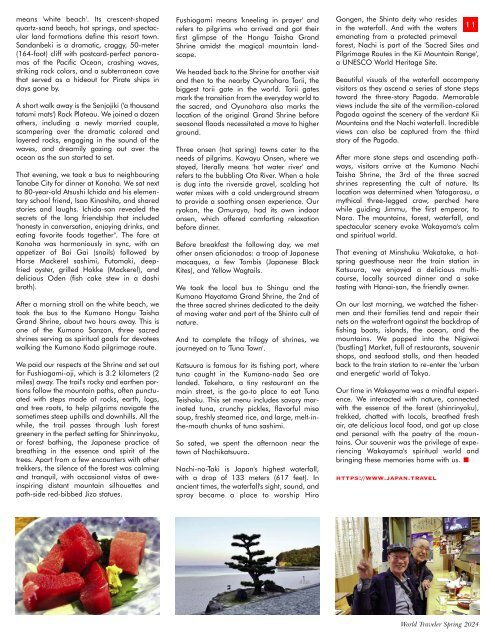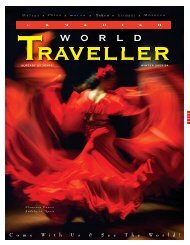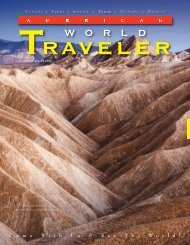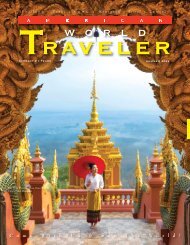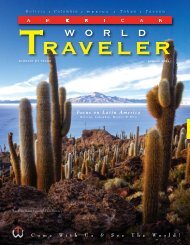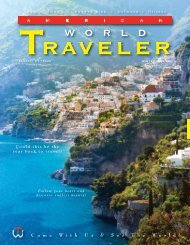Canadian World Traveller Spring 2024 Issue
Now in our 22nd year of publishing, World Traveler explores the culture and history of worldwide destinations, sharing the adventure of discovery with our readers and motivating them to make their travel dreams a reality. World Traveler helps sophisticated, independent travelers choose their next destination by offering a lively blend of intelligent, informative articles and tantalizing photographic images from the world’s best destinations, cruises, accommodations and activities to suit every traveler's taste.
Now in our 22nd year of publishing, World Traveler explores the culture and history of worldwide destinations, sharing the adventure of discovery with our readers and motivating them to make their travel dreams a reality. World Traveler helps sophisticated, independent travelers choose their next destination by offering a lively blend of intelligent, informative articles and tantalizing photographic images from the world’s best destinations, cruises, accommodations and activities to suit every traveler's taste.
Create successful ePaper yourself
Turn your PDF publications into a flip-book with our unique Google optimized e-Paper software.
means 'white beach'. Its crescent-shaped<br />
quartz-sand beach, hot springs, and spectacular<br />
land formations define this resort town.<br />
Sandanbeki is a dramatic, craggy, 50-meter<br />
(164-foot) cliff with postcard-perfect panoramas<br />
of the Pacific Ocean, crashing waves,<br />
striking rock colors, and a subterranean cave<br />
that served as a hideout for Pirate ships in<br />
days gone by.<br />
A short walk away is the Senjojiki ('a thousand<br />
tatami mats') Rock Plateau. We joined a dozen<br />
others, including a newly married couple,<br />
scampering over the dramatic colored and<br />
layered rocks, engaging in the sound of the<br />
waves, and dreamily gazing out over the<br />
ocean as the sun started to set.<br />
That evening, we took a bus to neighbouring<br />
Tanabe City for dinner at Konoha. We sat next<br />
to 80-year-old Atsushi Ichida and his elementary<br />
school friend, Isao Kinoshita, and shared<br />
stories and laughs. Ichida-san revealed the<br />
secrets of the long friendship that included<br />
'honesty in conversation, enjoying drinks, and<br />
eating favorite foods together". The fare at<br />
Konoha was harmoniously in sync, with an<br />
appetizer of Bai Gai (snails) followed by<br />
Horse Mackerel sashimi, Futomaki, deepfried<br />
oyster, grilled Hokke (Mackerel), and<br />
delicious Oden (fish cake stew in a dashi<br />
broth).<br />
After a morning stroll on the white beach, we<br />
took the bus to the Kumano Hongu Taisha<br />
Grand Shrine, about two hours away. This is<br />
one of the Kumano Sanzan, three sacred<br />
shrines serving as spiritual goals for devotees<br />
walking the Kumano Kodo pilgrimage route.<br />
We paid our respects at the Shrine and set out<br />
for Fushiogami-oji, which is 3.2 kilometers (2<br />
miles) away. The trail's rocky and earthen portions<br />
follow the mountain paths, often punctuated<br />
with steps made of rocks, earth, logs,<br />
and tree roots, to help pilgrims navigate the<br />
sometimes steep uphills and downhills. All the<br />
while, the trail passes through lush forest<br />
greenery in the perfect setting for Shinrinyoku,<br />
or forest bathing, the Japanese practice of<br />
breathing in the essence and spirit of the<br />
trees. Apart from a few encounters with other<br />
trekkers, the silence of the forest was calming<br />
and tranquil, with occasional vistas of aweinspiring<br />
distant mountain silhouettes and<br />
path-side red-bibbed Jizo statues.<br />
Fushiogami means 'kneeling in prayer' and<br />
refers to pilgrims who arrived and got their<br />
first glimpse of the Hongu Taisha Grand<br />
Shrine amidst the magical mountain landscape.<br />
We headed back to the Shrine for another visit<br />
and then to the nearby Oyunohara Torii, the<br />
biggest torii gate in the world. Torii gates<br />
mark the transition from the everyday world to<br />
the sacred, and Oyunohara also marks the<br />
location of the original Grand Shrine before<br />
seasonal floods necessitated a move to higher<br />
ground.<br />
Three onsen (hot spring) towns cater to the<br />
needs of pilgrims. Kawayu Onsen, where we<br />
stayed, literally means 'hot water river' and<br />
refers to the bubbling Ota River. When a hole<br />
is dug into the riverside gravel, scalding hot<br />
water mixes with a cold underground stream<br />
to provide a soothing onsen experience. Our<br />
ryokan, the Omuraya, had its own indoor<br />
onsen, which offered comforting relaxation<br />
before dinner.<br />
Before breakfast the following day, we met<br />
other onsen aficionados: a troop of Japanese<br />
macaques, a few Tombis (Japanese Black<br />
Kites), and Yellow Wagtails.<br />
We took the local bus to Shingu and the<br />
Kumano Hayatama Grand Shrine, the 2nd of<br />
the three sacred shrines dedicated to the deity<br />
of moving water and part of the Shinto cult of<br />
nature.<br />
And to complete the trilogy of shrines, we<br />
journeyed on to 'Tuna Town'.<br />
Katsuura is famous for its fishing port, where<br />
tuna caught in the Kumano-nada Sea are<br />
landed. Takehara, a tiny restaurant on the<br />
main street, is the go-to place to eat Tuna<br />
Teishoku. This set menu includes savory marinated<br />
tuna, crunchy pickles, flavorful miso<br />
soup, freshly steamed rice, and large, melt-inthe-mouth<br />
chunks of tuna sashimi.<br />
So sated, we spent the afternoon near the<br />
town of Nachikatsuura.<br />
Nachi-no-Taki is Japan's highest waterfall,<br />
with a drop of 133 meters (617 feet). In<br />
ancient times, the waterfall's sight, sound, and<br />
spray became a place to worship Hiro<br />
Gongen, the Shinto deity who resides<br />
in the waterfall. And with the waters<br />
11<br />
emanating from a protected primeval<br />
forest, Nachi is part of the 'Sacred Sites and<br />
Pilgrimage Routes in the Kii Mountain Range',<br />
a UNESCO <strong>World</strong> Heritage Site.<br />
Beautiful visuals of the waterfall accompany<br />
visitors as they ascend a series of stone steps<br />
toward the three-story Pagoda. Memorable<br />
views include the site of the vermilion-colored<br />
Pagoda against the scenery of the verdant Kii<br />
Mountains and the Nachi waterfall. Incredible<br />
views can also be captured from the third<br />
story of the Pagoda.<br />
After more stone steps and ascending pathways,<br />
visitors arrive at the Kumano Nachi<br />
Taisha Shrine, the 3rd of the three sacred<br />
shrines representing the cult of nature. Its<br />
location was determined when Yatagarasu, a<br />
mythical three-legged crow, perched here<br />
while guiding Jimmu, the first emperor, to<br />
Nara. The mountains, forest, waterfall, and<br />
spectacular scenery evoke Wakayama's calm<br />
and spiritual world.<br />
That evening at Minshuku Wakatake, a hotspring<br />
guesthouse near the train station in<br />
Katsuura, we enjoyed a delicious multicourse,<br />
locally sourced dinner and a sake<br />
tasting with Hanai-san, the friendly owner.<br />
On our last morning, we watched the fishermen<br />
and their families tend and repair their<br />
nets on the waterfront against the backdrop of<br />
fishing boats, islands, the ocean, and the<br />
mountains. We popped into the Nigiwai<br />
('bustling') Market, full of restaurants, souvenir<br />
shops, and seafood stalls, and then headed<br />
back to the train station to re-enter the 'urban<br />
and energetic' world of Tokyo.<br />
Our time in Wakayama was a mindful experience.<br />
We interacted with nature, connected<br />
with the essence of the forest (shinrinyoku),<br />
trekked, chatted with locals, breathed fresh<br />
air, ate delicious local food, and got up close<br />
and personal with the poetry of the mountains.<br />
Our souvenir was the privilege of experiencing<br />
Wakayama's spiritual world and<br />
bringing these memories home with us.<br />
https://www.japan.travel<br />
<strong>World</strong> Traveler <strong>Spring</strong> <strong>2024</strong>


